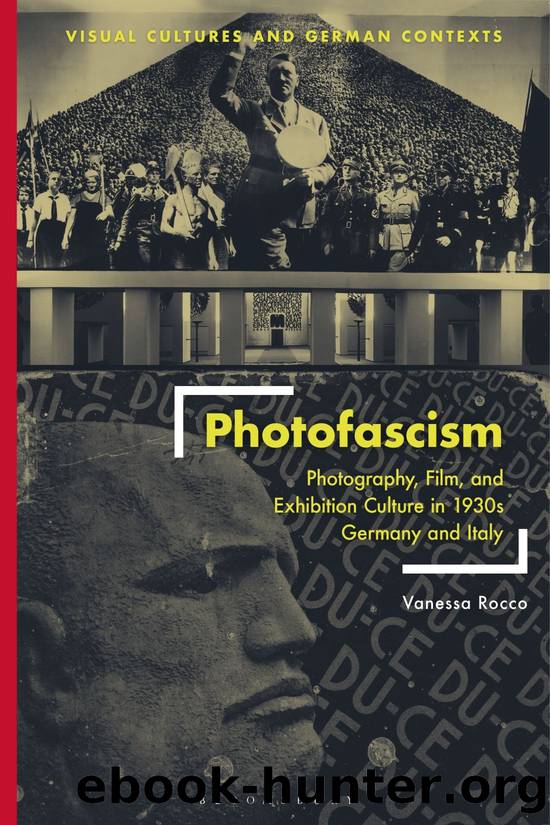Photofascism by Vanessa Rocco;

Author:Vanessa Rocco;
Language: eng
Format: epub
ISBN: 9781501347078
Publisher: Bloomsbury USA
Figure 4.3 The Blue Light (director Leni Riefenstahl), 1932. Courtesy Stiftung Deutsche Kinemathek.
The 1934 Festival: First Year after the Reich
More countries participated in 1934, including Austria, Czechoslovakia, Denmark, France, Germany, Great Britain, Italy, Holland, Spain, Unite d States, Sweden, Switzerland, Turkey, the Soviet Union, and even India. Japan also participated but only in the documentary section. This was also the first competitive edition. Germanyâs submissions in its first year of film products created under the Reich demonstrate the increasingly centralized tenor of film production. What the Italians desired to show off their own products on their home turf continued to straddle escapist continuity in its feature film selections, while increasing the intensity of the Fascist didactics of the documentaries, Mussoliniâs preferred genre.
In contrast to his effusive words about 1932, Wollenburg describes the âmelancholy interestâ of scanning the titles of films during the Reich, beginning in 1934, and also to scan filmmakers who had previously produced films for Germany but were at that point submitting for other countries due to the Nazi takeover, including Fritz Lang, Max Ophüls, and Billy Wilder.
The Germans had only two feature films: Reifende Jugend (Ripening Youth) by Carl Froelich and Flüchtlige (Refugees) by Gustav Ucicky. The documentary entries included three abstract films by Oskar Fischinger, Carmen by Lotte Reininger (âa film in silhouettesâ), Was ist die Welt (What Is the World) by Sven Noldan, and Deutschland Zwischen Gestern und Heute (Germany between Yesterday and Today), a cultural look at the German people by Wilfried Basse. It was described as a cross-section of documentary and âassemblage,â as used in the genre of the city symphony film.39
Froelichâs film was based on a play by Max Dreyer, a writer who pledged allegiance to Hitler. By 1933 when it was made, Froelich was an old-timer who, in Kracauerâs words, âdid not mind occupying a key post in the Nazi film industry.â40 Wollenburg describes this Froelich film as fairly traditional, in his mind showing that it took a while for the Nazi iron grip to solidify in cinema: âThe change, however, was gradual and it was some years before Goebbelsâ all-embracing power was completely obvious in the German selections for the Venice Festival.â41 In that sense, film consolidation mirrored other cultural consolidations from 1933 to 1936. Kracauer also has a note of interest about Froelich assisting Sagan with Maidens in Uniform, so Froelich was definitively indicative of major shifts in cultural orientation.42
In fact, this may be a perfect representation of the attitudinal shift that took place in Germany between 1931 and 1933 and the resulting sifted sands that finally solidified by the mid-1930s: the man who helped the subversive Sagan went on to work for Hitler. Wollenburg is not terribly clear on his opinion of the timing of solidification, but does state that firm changes against experimentation in German film were clear by 1935â6, a similar time frame as when photo exhibitions were solidifying their Führer cult, explored in Chapter 5.43 One of the reasons for including the Appendix at the
Download
This site does not store any files on its server. We only index and link to content provided by other sites. Please contact the content providers to delete copyright contents if any and email us, we'll remove relevant links or contents immediately.
Shoot Sexy by Ryan Armbrust(17153)
Portrait Mastery in Black & White: Learn the Signature Style of a Legendary Photographer by Tim Kelly(16493)
Adobe Camera Raw For Digital Photographers Only by Rob Sheppard(16398)
Photographically Speaking: A Deeper Look at Creating Stronger Images (Eva Spring's Library) by David duChemin(16166)
Bombshells: Glamour Girls of a Lifetime by Sullivan Steve(13120)
Art Nude Photography Explained: How to Photograph and Understand Great Art Nude Images by Simon Walden(12356)
Perfect Rhythm by Jae(4629)
Pillow Thoughts by Courtney Peppernell(3417)
The Book of Joy by Dalai Lama(3239)
Good by S. Walden(2922)
The Pixar Touch by David A. Price(2745)
Fantastic Beasts: The Crimes of Grindelwald by J. K. Rowling(2551)
A Dictionary of Sociology by Unknown(2522)
Humans of New York by Brandon Stanton(2383)
Read This If You Want to Take Great Photographs by Carroll Henry(2307)
Stacked Decks by The Rotenberg Collection(2284)
On Photography by Susan Sontag(2137)
Photographic Guide to the Birds of Indonesia by Strange Morten;(2093)
Insomniac City by Bill Hayes(2088)
